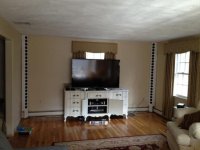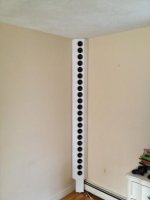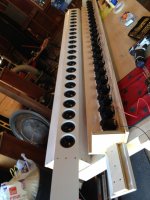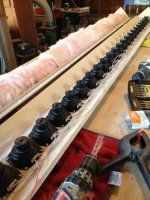Part 1
I need to preface what i'm going to say by stating i am not an expert at audio/speaker building and I do not have a good reference point to use as a comparison for the MCLA's.
The beta version of the speakers are done and in. I'm designating them as beta versions because I think some tweaking is required.
Configuration-
emotiva umc1 preamp/processor
Mcintosh mc2100
Sonos, digital output, all lossless music
Current speakers- paradigm studio 60
Behringer deq2496
MCLA config-
7 feet long
22 Aura 3" 8 ohm drivers per side
Flat eq settings based on mcla spec
Room-
13x25x7.5
Speakers on short wall
Single double pane window 4 feet from each speaker
Hardwood floors
Not much absorptive material in room
First impression (highly subjective)
Bass a little boomy
Highs somewhat muted
Lacks precision (crack of the drum, tight bass)
Off axis dispersion (approx 25 deg) noticeable decrease in highs
Things I can tweak-
Maybe i have too much/little insulation in box
Seal box better with silicon
Eq settings
Change equipment (amp, source)
I need to preface what i'm going to say by stating i am not an expert at audio/speaker building and I do not have a good reference point to use as a comparison for the MCLA's.
The beta version of the speakers are done and in. I'm designating them as beta versions because I think some tweaking is required.
Configuration-
emotiva umc1 preamp/processor
Mcintosh mc2100
Sonos, digital output, all lossless music
Current speakers- paradigm studio 60
Behringer deq2496
MCLA config-
7 feet long
22 Aura 3" 8 ohm drivers per side
Flat eq settings based on mcla spec
Room-
13x25x7.5
Speakers on short wall
Single double pane window 4 feet from each speaker
Hardwood floors
Not much absorptive material in room
First impression (highly subjective)
Bass a little boomy
Highs somewhat muted
Lacks precision (crack of the drum, tight bass)
Off axis dispersion (approx 25 deg) noticeable decrease in highs
Things I can tweak-
Maybe i have too much/little insulation in box
Seal box better with silicon
Eq settings
Change equipment (amp, source)
Part 2
1. Pictures for the project will be uploader later today
2. I've gotten better at using the DEQ2496 (RTA, GEQ, PEQ). I have 3 memory settings at this time (a. MCLA specified settings-flat response, b. RTA AutoEQ, c. my ear/interpretation)
3. I still am very dissappointed with the sound. Very colored, minimal impact.
4. I have not done measurements, but it appears as if the off access reponse drops off very quckly.
5. Positives- bass response appears to be pretty good. Nowhere near as good as my infinite baffle sub in my family room.
Next steps:
1. Continue to muck around with my ear/interpretation curve
2. I'm going to give it a couple more weeks. If I'm not happy at that time I'll sell the speakers (for cost of the drivers) without the DEQ2496.
I'm open to suggestions.
1. Pictures for the project will be uploader later today
2. I've gotten better at using the DEQ2496 (RTA, GEQ, PEQ). I have 3 memory settings at this time (a. MCLA specified settings-flat response, b. RTA AutoEQ, c. my ear/interpretation)
3. I still am very dissappointed with the sound. Very colored, minimal impact.
4. I have not done measurements, but it appears as if the off access reponse drops off very quckly.
5. Positives- bass response appears to be pretty good. Nowhere near as good as my infinite baffle sub in my family room.
Next steps:
1. Continue to muck around with my ear/interpretation curve
2. I'm going to give it a couple more weeks. If I'm not happy at that time I'll sell the speakers (for cost of the drivers) without the DEQ2496.
I'm open to suggestions.
About:
> Highs somewhat muted
This is probably because of the interference between the drivers, and I expect that your DEQ can fix that.
How did you wire the speakers? I ask because I once read an interesting article that proposed a wiring so that more sound came out of the middle speakers than the ones at the ends of the array. This decreased the effects of interference.
For the bass, have you tried moving the array a bit away rom the corner?
> Highs somewhat muted
This is probably because of the interference between the drivers, and I expect that your DEQ can fix that.
How did you wire the speakers? I ask because I once read an interesting article that proposed a wiring so that more sound came out of the middle speakers than the ones at the ends of the array. This decreased the effects of interference.
For the bass, have you tried moving the array a bit away rom the corner?
Hat down for the job done ( so much holes and the wiring !) and for your lucidity, it barely happens that a proud DIYer could criticize his product.
What I think is that you have to measure to got a clear idea. Compare a lonely driver and the whole array. You will probably also discover some timing errors that can result in noticeable cancellations, that's classic with a straight array and adds up with the mandatory comb effect.
I think that you have to maximize the listening distance, then you could try either a power tapering ( the best in your case), either a frequency tapering, either both. You can do the power tapering by changes in the wiring and playing with the resulting impedances, but of course the frequency tapering will reduce the highs.
An other solution if you still have four spare drivers is to try a Bessel wiring, it works with 25 drivers. I have some experience with the Bessel five, I like much more the power tapering on an incurved array, but maybe it's worth the try.
Last word, don't waste time or energy when thinking of the responsibility of the electronics.
What I think is that you have to measure to got a clear idea. Compare a lonely driver and the whole array. You will probably also discover some timing errors that can result in noticeable cancellations, that's classic with a straight array and adds up with the mandatory comb effect.
I think that you have to maximize the listening distance, then you could try either a power tapering ( the best in your case), either a frequency tapering, either both. You can do the power tapering by changes in the wiring and playing with the resulting impedances, but of course the frequency tapering will reduce the highs.
An other solution if you still have four spare drivers is to try a Bessel wiring, it works with 25 drivers. I have some experience with the Bessel five, I like much more the power tapering on an incurved array, but maybe it's worth the try.
Last word, don't waste time or energy when thinking of the responsibility of the electronics.
IIRC, a floor to ceiling line source will (in theory) have a frequency response that slopes downward at 3dB/octave. Nothing you can't fix with an equalizer.Bass a little boomy
Highs somewhat muted
Did you ever resolve whither you have the correct drivers?
(I couldn't follow the thread)
Murphy Corner Line Array (MCLA) - Page 9 - Techtalk Speaker Building, Audio, Video, and Electronics Customer Discussion Forum From Parts-Express.com
In any case John Murphy is a knowledgeable and skilled loudspeaker designer. I'm sure that a correctly built speaker will measure the same as his test results.
But in some rooms a corner line array may sound very different than a more compact speaker that is in a different room location.
(I couldn't follow the thread)
Murphy Corner Line Array (MCLA) - Page 9 - Techtalk Speaker Building, Audio, Video, and Electronics Customer Discussion Forum From Parts-Express.com
In any case John Murphy is a knowledgeable and skilled loudspeaker designer. I'm sure that a correctly built speaker will measure the same as his test results.
But in some rooms a corner line array may sound very different than a more compact speaker that is in a different room location.
I started a thread on the "Official" forum on the Parts Express site and I received very little response. It does not appear that John Murphy has been very active on the various forums for a couple of years.
Comb Effect:
John states on his Deign Concept page that the MCLA addresses comb filtering.
The Murphy Corner-Line-Array Design Concepts
I am starting to think it is comb effect and that I need to address this. I may change the wiring from my current configuration (4 sets of 5 8 ohm drivers, each set in series) + (2 8 ohm drivers, in series) connected in parallel, to a power tapering configuration.
Speedskater- I ended up going with Aura drivers, which appear to be the same as the PE drivers.
Comb Effect:
John states on his Deign Concept page that the MCLA addresses comb filtering.
The Murphy Corner-Line-Array Design Concepts
I am starting to think it is comb effect and that I need to address this. I may change the wiring from my current configuration (4 sets of 5 8 ohm drivers, each set in series) + (2 8 ohm drivers, in series) connected in parallel, to a power tapering configuration.
Speedskater- I ended up going with Aura drivers, which appear to be the same as the PE drivers.
I have been founding these plots about your drivers :
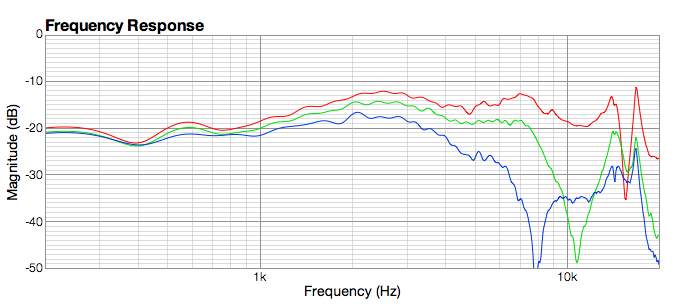
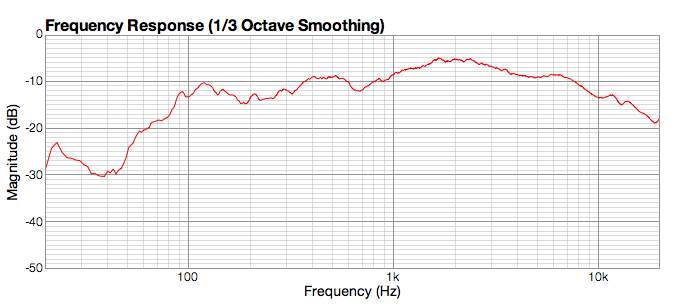
If you say that the array bass level is Ok, it's already something positive, but the over 1000 Hz part is not very nice. You can correct most of the axis response with the DEQ but the off axis will stay as it is ( BTW, these measurements are done on a 10 cm wide 2.5 liter sealed baffle).
The question is to know what this becomes with 22 stacked drivers and in what it contributes to the final result. The answer is that you have to measure this with something else that the embedded RTA of the DEQ. I guess you already have a mike. With a good sound card and one of the many free programs around, it's done.
What are you planning for the tapering ? I think that some people have been using serie resistors with an increment value of 0.2 or 0.3 ohms. After 10 steps you are at 2 ohms, this can be tried if you don't find a more elegant solution with the serie/parallel wiring.
If you say that the array bass level is Ok, it's already something positive, but the over 1000 Hz part is not very nice. You can correct most of the axis response with the DEQ but the off axis will stay as it is ( BTW, these measurements are done on a 10 cm wide 2.5 liter sealed baffle).
The question is to know what this becomes with 22 stacked drivers and in what it contributes to the final result. The answer is that you have to measure this with something else that the embedded RTA of the DEQ. I guess you already have a mike. With a good sound card and one of the many free programs around, it's done.
What are you planning for the tapering ? I think that some people have been using serie resistors with an increment value of 0.2 or 0.3 ohms. After 10 steps you are at 2 ohms, this can be tried if you don't find a more elegant solution with the serie/parallel wiring.
Thank you for your assistance. You've confirmed my thought that I need a better measurement system than the DEQ. Can you recommend a no/low cost option for me? As far as the rewiring to address the comb effect is concerned, I'll wait until I have time to do some research and get the measurement system in place.
lack of sharpness ? That's because your leading edge is smeared. You hear the closest drivers, than the next, etc, until you hear the last ones (3.5" have good dispersion).
Read about the kuze array, especially his notes on the freq response of 1 driver, the freq response unequalized of the array, and lastly the transient response.
Parts Express: Project Showcase
Even if you eq in the highs, it still didn't sparkle.
If you are the only 1 listening to the music, you could focus all those drivers to 1 spot in the room. I made a 4 x 4" and within the constraints of the area of an 8" (4x4" sd about equal to a 1x8"), mass corner of 225hz (drivers roll off in an infinite baffle or ob), and open baffle Feq +6db hump then falling off at 180hz, it is amazing. But it sounded horrible everywhere but the sweet spot, about the size of a football. And a 150hz-200hz crossover point seemed to mess up the bass. My music is bassy and used for action movies, so I'd need more cone area, like 9x4" or 16x4".
Here were my inspirations.
COPERNICUS by ATS - Images
and
Open Baffle Line Array Speakers
To me, a flat array sounds too tall, a wall of flat sound, even 20-30' away, like a closeup of a pair of lips on a movie screen. Curving the array allows all the benefits of a full range driver but with the bonus of real volume, but at a serious drawback. Full range drivers offer superior intelligibility that really can make a movie much more interesting (like all the background stuff in thx-1138), and you get bass by using a bunch of em.
Even focusing it, that rise in the past 1khz will need to be eq'd down or notched.
Norman
Read about the kuze array, especially his notes on the freq response of 1 driver, the freq response unequalized of the array, and lastly the transient response.
Parts Express: Project Showcase
Even if you eq in the highs, it still didn't sparkle.
If you are the only 1 listening to the music, you could focus all those drivers to 1 spot in the room. I made a 4 x 4" and within the constraints of the area of an 8" (4x4" sd about equal to a 1x8"), mass corner of 225hz (drivers roll off in an infinite baffle or ob), and open baffle Feq +6db hump then falling off at 180hz, it is amazing. But it sounded horrible everywhere but the sweet spot, about the size of a football. And a 150hz-200hz crossover point seemed to mess up the bass. My music is bassy and used for action movies, so I'd need more cone area, like 9x4" or 16x4".
Here were my inspirations.
COPERNICUS by ATS - Images
and
Open Baffle Line Array Speakers
To me, a flat array sounds too tall, a wall of flat sound, even 20-30' away, like a closeup of a pair of lips on a movie screen. Curving the array allows all the benefits of a full range driver but with the bonus of real volume, but at a serious drawback. Full range drivers offer superior intelligibility that really can make a movie much more interesting (like all the background stuff in thx-1138), and you get bass by using a bunch of em.
Even focusing it, that rise in the past 1khz will need to be eq'd down or notched.
Norman
At no cost come some softs like Arta demo, fully functional except for the beautiful polars, Holm impulse ( needs framework 2), REW. Each having it's own advantages, for the price take all.
If you don't have a mike (?) you can search for a Panasonic capsule ( WM-61) or can go for the Dayton audio EMM-6 that is cheap and supposedly calibrated.
Next step is the sound card, USB, Firewire or internal, there is a lot of expensive choices. It depends also if you have a desktop or laptop. For the cheap side, here I have no clue, google it. Make sure that it can do at least the 24/96 and that it's a full duplex.
Note that a good sound card is not wasting money because you can use it later for listening music...but in this case ( as for measuring) it's better to enter in the DEQ by the SPDIF, so you don't care of the quality of the sound card DAC. One more saving.
If you don't have a mike (?) you can search for a Panasonic capsule ( WM-61) or can go for the Dayton audio EMM-6 that is cheap and supposedly calibrated.
Next step is the sound card, USB, Firewire or internal, there is a lot of expensive choices. It depends also if you have a desktop or laptop. For the cheap side, here I have no clue, google it. Make sure that it can do at least the 24/96 and that it's a full duplex.
Note that a good sound card is not wasting money because you can use it later for listening music...but in this case ( as for measuring) it's better to enter in the DEQ by the SPDIF, so you don't care of the quality of the sound card DAC. One more saving.
- Status
- This old topic is closed. If you want to reopen this topic, contact a moderator using the "Report Post" button.
- Home
- Loudspeakers
- Full Range
- MCLA (Murphy Corner Line Array) project
